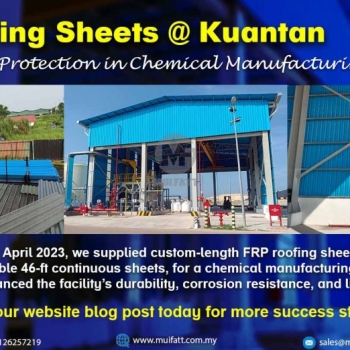In 2024, Mui Fatt supplied 915 custom FRP bollards to Majlis Perbandaran Muar (MPM), Johor, enhancing urban aesthetics and pedestrian safety along Jalan Maharani and Jalan Petrie. Designed in black and gold with the MPM logo, these durable, corrosion-resistant bollards offer a long-lasting alternative to traditional metal options, reinforcing Muar’s identity as Bandar Diraja.
Understanding Fire Safety Regulations - Fire Tank materials
30 Oct 2024
Fire Tank Regulation in Malaysia
Fire Tank Regulation in Malaysia
- Key Takeaways
- What is a Fire Tank?
- Common Materials Used for Fire Tanks Worldwide
- Understanding the Different Types of Tanks
- Fire Tank Regulations in Malaysia
- Future Trends in Fire Tank Regulations
- Conclusion
- Frequently Asked Questions (FAQs)
Key Takeaways
- Fire tanks are crucial for fire safety, providing a reliable water source for firefighting.
- In Malaysia, fire tanks are required in certain buildings and must be constructed from approved materials like steel and concrete.
- FRP (Fiberglass Reinforced Plastic), while not accepted for fire tanks, is widely used for suction tanks and reservoir tanks due to its durability and corrosion resistance.
- Understanding the distinctions between fire tanks, suction tanks, and reservoir tanks is essential for compliance and safety.
What is a Fire Tank?
Definition and purpose of fire tanks in firefighting
A fire tank is a specialized water storage facility designed specifically for firefighting purposes. These tanks provide a dedicated water source for fighting fires effectively, ensuring quick access during emergencies and protection. Fire tanks, water storage containers, are often mandated in commercial and residential buildings that meet specific height or occupancy standards to aid in fighting fires, as dictated by local fire safety regulations.
Importance of compliance with local regulations
The importance of fire tanks cannot be overstated; they play a vital role in safeguarding lives and property by supplying water to fire suppression systems, such as sprinklers and hydrants. Ensuring that fire tanks meet regulatory compliance is essential fire safety management.
Common Materials Used for Fire Tanks Worldwide
Overview of widely accepted materials (steel, concrete)
Globally, various materials are accepted for constructing fire tanks, with steel and concrete being the most prevalent. These materials are favored for their durability, structural integrity, and ability to withstand high temperatures. Here's a brief overview of commonly accepted materials:
-
Steel Tanks: Known for their strength and longevity, steel tanks can be designed to withstand significant pressure and are often coated for additional protection against corrosion.
-
Concrete Tanks: These tanks are robust and offer excellent fire resistance, making them suitable for both above-ground and underground applications.
Discussion on why FRP (Fiberglass Reinforced Plastic) is not accepted in Malaysia
While FRP (Fiberglass Reinforced Plastic) has been gaining traction in some countries as an alternative fire tank material under certain guidelines, Malaysia maintains a conservative approach to fire tank regulations. The primary concerns surrounding FRP include:
-
Fire Resistance: Although FRP can be treated to improve its fire resistance, it does not offer the same level of fireproofing as steel or concrete. This has led to skepticism regarding its ability to withstand extreme temperatures during a fire.
-
Regulatory Standards: Malaysian regulations emphasize the importance of using traditional materials that have a proven track record of performance in firefighting applications. Until there is substantial evidence supporting the efficacy of FRP in fire tanks, its acceptance remains limited.
Understanding the Different Types of Tanks
-
Suction Tank
-
Purpose: A suction tank primarily serves as an intermediary storage system for water, maintaining a steady supply for pumps that transport water to various points in a system. Suction tanks are commonly found in high-rise buildings, industrial sites, and areas where constant water pressure needs to be maintained for fire protection purposes.
-
Function: They are connected to a pump that draws or "sucks" water from the tank and pushes it into the distribution system. This setup ensures stable water flow and pressure for essential functions, especially in firefighting or domestic water supply.
-
Application: Suction tanks can be part of fire suppression systems, helping ensure the pump receives a steady water supply to distribute during a fire emergency.
-
-
Reservoir Tank
-
Purpose: A reservoir tank is a large storage unit designed to hold water, typically for long-term storage and general distribution across a facility, community, or industrial system.
-
Function: Reservoirs can serve as a main water source for municipal systems or large facilities, helping ensure there’s enough water to meet daily demand. They are often built with a significant volume capacity, allowing them to hold substantial amounts of water to buffer against usage spikes or supply interruptions.
-
Application: While reservoir tanks can serve as sources for firefighting water, they are not specifically designed to meet the dedicated and rapid-access needs of firefighting systems, which is where fire tanks come in.
-
-
Fire Tank
-
Purpose: Fire tanks are specialized storage tanks that supply water exclusively for firefighting purposes. They are typically required to adhere to strict fire safety standards to ensure they are accessible and reliable in emergencies.
-
Function: Fire tanks are designed to provide immediate access to large volumes of water for fire suppression. They often include a dedicated piping system, control valves, and reliable pumps for fire protection purpose to supply water quickly to sprinkler systems, hoses, or hydrants. Fire tanks are often kept isolated from other water demands to ensure they are always full and ready for use in an emergency.
-
Application: Fire tanks are essential for compliance with fire codes, as they provide a dedicated, uninterruptible water source for fire suppression.
-
Is a Reservoir Tank the Same as a Fire Tank?
While a reservoir tank can be used as a water source for firefighting in some cases, it is generally not the same as a dedicated fire tank. Reservoir tanks serve multiple purposes, while fire tanks are reserved for emergencies, providing a controlled and reliable source of water for fire systems. Fire tanks are also more likely to have design features that enhance their reliability in emergency scenarios, such as reinforced materials, quick access points, and compliance with fire-specific codes.
Comparison of Suction Tanks, Reservoir Tanks, and Fire Tanks
|
Feature |
Suction Tank |
Reservoir Tank |
Fire Tank |
|---|---|---|---|
|
Purpose |
Steady supply for pumps |
Stores large volumes of water |
Dedicated firefighting water supply |
|
Material |
Often FRP, concrete, or steel |
Typically FRP, concrete, or steel |
Commonly steel or concrete |
|
Usage |
Support pressure systems |
General facility or municipal supply |
Specifically for fire suppression |
|
Special Requirements |
Pump compatibility |
General construction standards |
Fire safety standards compliance |
|
Design |
Usually pressurized |
Open or closed design |
Must maintain specific fire codes |
In fire protection systems, having both a reservoir and a dedicated fire tank (or ensuring compliance if using a reservoir as a backup) is important for maintaining emergency preparedness and regulatory compliance. While FRP is not accepted for fire tanks in Malaysia, it is commonly utilized in the construction of suction and reservoir tanks. This is due to its lightweight, corrosion-resistant properties, making it an ideal choice for applications where long-term durability is required.
Fire Tank Regulations in Malaysia
In Malaysia, fire tank regulations are governed by standards set forth by the Department of Occupational Safety and Health (DOSH) and the Fire and Rescue Department of Malaysia. These regulations mandate the installation of fire tanks in buildings exceeding certain heights or occupancy levels.
Key points of these regulations include:
-
Fire tanks must be easily accessible for firefighting vehicles.
-
The tanks must have a minimum water capacity for fire protection purpose, depending on the type and height of the building.
-
Regular maintenance and inspections are required to ensure that the tanks remain functional and compliant with safety standards.
Challenges in navigating these regulations often arise for property developers and contractors, particularly regarding compliance and material selection. Understanding the specific requirements can streamline the approval process and avoid potential setbacks.
Future Trends in Fire Tank Regulations
As fire safety technology continues to evolve, there may be opportunities for changes in regulations regarding alternative materials like FRP. Advocacy and research into the performance of such materials could influence future acceptance of Malaysian standards.
Emerging trends in fire safety emphasize the importance of innovation while maintaining high safety standards. As a result, it is crucial for stakeholders, including fire safety professionals and material manufacturers, to collaborate on research and development efforts to explore safer, more effective alternatives.
Conclusion
Fire tanks play a critical role in ensuring public safety during emergencies. Understanding the regulations governing fire tanks in Malaysia, the materials permitted for use, and the differences between various types of tanks is essential for compliance and effective fire safety management. While FRP is not accepted for fire tanks in Malaysia, its widespread use in suction and reservoir tanks highlights its versatility and durability as a material. As the industry evolves, the potential for change remains, paving the way for improved fire safety solutions in the future.
Frequently Asked Questions (FAQs)
What is the purpose of a fire tank?
Fire tanks are designed to provide a dedicated water supply for firefighting, ensuring accessibility during emergencies.
Are fire tanks required in all buildings in Malaysia?
Not all buildings require fire tanks; regulations apply based on the building's height and occupancy.
What materials are typically used for fire tanks?
Common materials include steel and concrete, which are preferred for their strength and compliance with safety standards.
Can FRP be used for fire tanks in Malaysia?
Currently, FRP is not accepted as a material for fire tanks in Malaysia due to safety and regulatory concerns, but it is widely used for suction and reservoir tanks.
What is the difference between a fire tank and a reservoir tank?
A fire tank is specifically designed for firefighting, while a reservoir tank is used for general water supply and may also serve firefighting needs.
Disclaimer:-
The information provided on this website is for general informational purposes only and does not constitute legal advice. While we strive to ensure the accuracy and reliability of the information provided, we make no representations or warranties of any kind, express or implied, about the completeness, accuracy, reliability, suitability, or availability concerning the information contained herein. Any reliance you place on such information is therefore strictly at your own risk. This website may contain links to other third-party websites. Such links are only for the convenience of the reader, user, or browser; which we do not warrant, recommend, endorse, or assume liability for the contents of the third-party sites.
Keep in touch with us should you be keen on receiving timely updates from us
- Website - https://www.muifatt.com.my/home/
- Facebook - https://www.facebook.com/muifattmarketing
- Instagram - https://www.instagram.com/muifattmarketing/
- Google - https://goo.gl/maps/WxVY13gNcaRTS7Jp6
- Youtube - http://www.youtube.com/@MuiFattMarketing
- TikTok - https://www.tiktok.com/@muifattmarketing
- LinkedIn - https://www.linkedin.com/company/mui-fatt-marketing-sdn-bhd-
- Linktree - https://linktr.ee/muifattmarketing
- Shopee - https://www.shopee.com.my/muifattmarketing
- Lazada - https://www.lazada.com.my/shop/mui-fatt-marketing
Recent Blog
FRP Lipstick Benches for Sunway Pyramid’s Cosmetic Floor
In 2018, Mui Fatt supplied 6-8 FRP Lipstick Benches to Sunway Pyramid’s Cosmetic Floor, Ground Level, as part of the mall’s thematic interior design. These custom-made benches, shaped like lipstick tubes, remain in excellent condition, demonstrating the durability, aesthetic appeal, and longevity of FRP furniture.
Cut-to-Length FRP Roofing Supplied for Chemical Plant in Kuantan
In April 2023, we supplied custom-length FRP roofing sheets, including a remarkable 46-ft continuous sheet, for a chemical manufacturing plant in Kuantan. Primarily in Riviera Blue, with translucent sheets for natural lighting, the shipment was delivered in a single trip using a 46-ft flat loader. This project enhanced the facility’s durability, corrosion resistance, and light optimization.
FRP Planter Pots & Benches for Vista Alam, Shah Alam
In November 2015, Mui Fatt supplied high-quality FRP planter pots and FRP benches to Vista Alam Serviced Apartment, Shah Alam, enhancing the condominium's common areas with long-lasting and aesthetically pleasing outdoor furniture. The project featured sand-gritted earth-colored and two-tone blue FRP pots in various sizes, along with uniquely designed number-shaped and rectangular FRP benches. These weather-resistant and low-maintenance solutions provided functional and decorative enhancements to the living environment.
The FRP Pultrusion Process: A Guide to Strength & Efficiency
FRP pultrusion is a continuous manufacturing process that produces strong, lightweight, and corrosion-resistant profiles. This article explains how the process works, its advantages, and how it compares to other FRP fabrication techniques, helping you choose the right material for your project.
Supplying FRP Caged Ladders to Edra Melaka Power Plant: Safe & Durable Access Solutions
In 2024, we supplied and installed 19 FRP caged ladder units at Edra Melaka Power Plant (EMPP) in Alor Gajah, Melaka. The 6-meter-high ladders were installed in the seawater storage area to replace existing FRP ladders that had accumulated clam attachment byssal threads, which compromised their safety and durability. Our team of 10 workers completed the installation within three weeks, ensuring a seamless transition and an opportunity for skill enhancement.
FRP Planter Pots Enhancing Majlis Perbandaran Jasin (MPJ), Melaka’s Urban Landscape
In 2023, Mui Fatt successfully supplied nearly 1000 FRP planter pots to Majlis Perbandaran Jasin (MPJ), Melaka. These fiberglass planters were delivered in two phases—first, for decorative purposes at MPJ’s office front yard with LED-integrated translucent pots, and second, to enhance various locations throughout the city, including road dividers, roundabouts, and public facilities. Our weather-resistant and long-lasting FRP planter pots contribute to urban beautification while ensuring durability against harsh environmental conditions.
FRP Planter Pots Supplied to Sunway Pyramid for Oasis Opening
Mui Fatt proudly supplied 49 custom FRP planter pots in gold, black, and white to Sunway Pyramid for the Oasis Opening in November 2024. These stylish and durable planters enhance the indoor landscape with a modern touch while offering long-lasting performance. We appreciate Sunway Pyramid’s continued trust in our FRP products.











